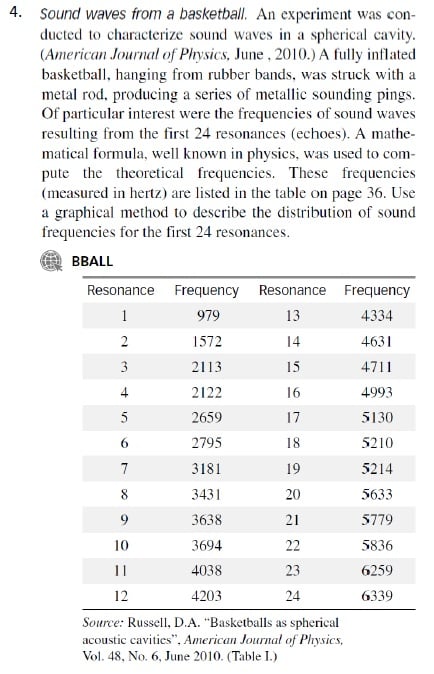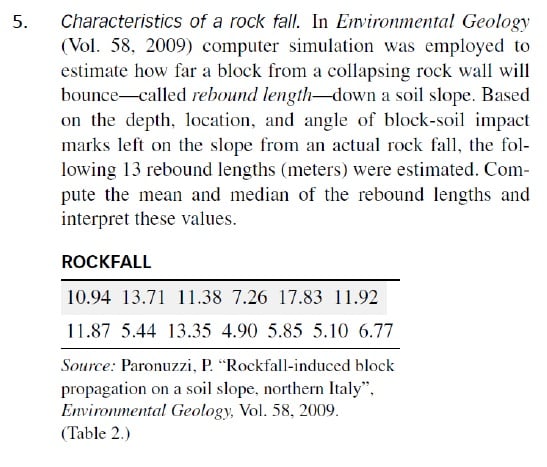4. Sound waves from a basketball. An experiment was con- ducted to characterize sound waves in a spherical cavity. (American Journal of Physics, June , 2010.) A fully inflated basketball, hanging from rubber bands, was struck with a metal rod. producing a series of metallic sounding pings. Of particular interest were the frequencies of sound waves resulting from the first 24 resonances (echoes). A mathe- matical formula, well known in physics, was used to com- pute the theoretical frequencies. These frequencies ( measured in hertz) are listed in the table on page 36. Use a graphical method to describe the distribution of sound frequencies for the first 24 resonances. BBALL Resonance Frequency Resonance Frequency 979 13 4334 1572 14 4631 3 2113 15 4711 2122 16 4993 2659 17 5130 2795 18 5210 3181 19 5214 3431 20 5633 3638 21 5779 10 3694 22 5836 1 4038 23 6259 12 4203 24 6339 Source: Russell, D.A. "Basketballs as spherical acoustic cavities". American Journal of Physics, Vol. 48. No. 6, June 2010. (Table L.)6. Crude oil blodegradation. Refer to the Journal of Petroleum Geology (April. 2010) study of the environmental factors associated with biodegradation in crude oil reservoirs, Exercise 2.18 (p. 37). Recall that amount of dioxide (mil- ligrams/liter) and presence/absence of crude oil was deter- mined for each of 16 water specimens collected from a mine reservoir. The data are repeated in the accompanying table. a. Find the mean dioxide level of the 16 water specimens. Interpret this value. b. Find the median dioxide level of the 16 water speci- mens. Interpret this value. C. Find the mode of the 16 dioxide levels. Interpret this value. d. Find the median dioxide level of the 10 water speci- mens with no crude oil present. e. Find the median dioxide level of the 6 water specimens with crude oil present. BIODEG Dioxide Amount Crude Oil Present 3.3 No 05 Yes 1.3 Yes Yes No 4.0 No 0.3 No Yes 2.4 No 2.4 No 14 No 0.5 Yes 0.2 Yes 40 No 4.0 No 4.0 No Source: Permanyer. A., et al. "Crude oil biodegradation and environmental factors at the Riutort oil shale mine. SE Pyrenees". Journal of Petroleum Geology, Vol. 33. No. 2, April 2010 (Table 1).5. Characteristics of a rock fall. In Environmental Geology (Vol. 58, 2009) computer simulation was employed to estimate how far a block from a collapsing rock wall will bounce-called rebound length-down a soil slope. Based on the depth, location, and angle of block-soil impact marks left on the slope from an actual rock fall, the fol- lowing 13 rebound lengths (meters) were estimated. Com- pute the mean and median of the rebound lengths and interpret these values. ROCKFALL 10.94 13.71 11.38 7.26 17.83 11.92 11.87 5.44 13.35 4.90 5.85 5.10 6.77 Source: Paronuzzi, P. "Rockfall-induced block propagation on a soil slope, northern Italy". Environmental Geology, Vol. 58, 2009. (Table 2.)









